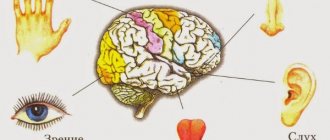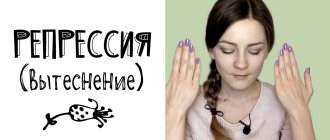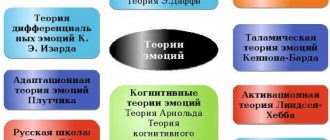Sensitization is an increase in the sensitivity of nerve centers under the influence of an irritant. Increased sensitivity can occur during anticipation of a significant signal, through experience, or as a result of exercise. It may be due to specific activity requirements or arise as a result of compensation for sensory defects. An example of sensitization in the first case is the high sensitivity of the artist's eye to the proportionality of shapes and the consistency of colors and shades. In the second, it is an increase in hearing and remote sensitivity to obstacles in blind people.
Sensitization, adaptation and synesthesia are directly related to changes in the sensitivity of analyzers and relate to the qualitative characteristics of sensations.
Concept and essence
Sensitization is a psychological concept that explains the increased sensitivity of nerve centers. Similar phenomena occur under the influence of various stimuli.
Organs that perceive information from the outside world:
- tongue - taste sensations;
- skin - exposure to temperature, chemicals;
- eyes - collect information about the size, shape, color of objects;
- nose - sense of smell;
- interoceptive receptors - sensations emanating from internal organs;
- vestibular apparatus - determining the position of the body in space;
- ligaments, tendons, muscles - movement.
With the help of functional analyzers, a person collects primary information. It is then transmitted to individual elements where it is analyzed. After the initial processing, the highest evaluation of the data occurs, which occurs in the cerebral cortex.
Diagnostic algorithm at the stage of identifying a medical problem
Algorithm for using molecular packages “Trees-1” and “Trees-2” to predict the effectiveness of ASIT
| Molecular package | Allergy components | Efficiency of ASIT |
| MP "Trees-1" | Main allergenic component Bet v 1 “+” minor allergic components Bet v 2 and Bet v 4 “-” | ASIT is effective |
| Main allergenic component Bet v 1 “ — ” Minor allergic components Bet v 2 and Bet v 4 — + | ASIT is not effective | |
| MP "Trees-2" | Main allergenic component Bet v 1 + minor allergenic components Bet v 2, Bet v 4, Bet v 6 — | ASIT is effective |
| Main allergenic component Bet v 1 — minor allergenic components Bet v 2, Bet v 4, Bet v 6 — + | ASIT is not effective |
Causes
Increased sensitivity of individual sensations occurs due to:
- Impact of medications. An exacerbation of receptor sensitivity is observed with the administration of phenamine or adrenaline.
- Simultaneous operation of different analyzers. When a person is very cold, the reaction to bright light increases. When some analyzers become less sensitive, others begin to work more actively and perceive more information.
- Psychological attitude. For example, a person is afraid to visit surgeons, but he needs to open a purulent abscess. Because it focuses on the irritating factor, the pain will intensify as the appointment date approaches.
- Following personal experience. The longer a person engages in any activity, the more developed his feelings associated with it are. For example, an artist sees shades of colors better, a musician catches notes and determines their length, a sommelier senses any notes of taste.
When one of the analyzers becomes aggravated, the sensitivity of the others decreases.
Story
Eric Kandel was one of the first to study the neural basis of sensitization, conducting experiments on the gill withdrawal reflex in the sea slug in the 1960s and 1970s. Aplysia
. Kandel and his colleagues first trained the reflex by dampening the response by repeatedly touching the animal's siphon. They then coupled a noxious electrical stimulus to the tail with touching the siphon, causing the gill-withdrawal response to reappear. After this sensitization, only a light touch on the siphon caused a strong gill withdrawal response, and this sensitization effect lasted for several days. (After Squire and Kandel, 1999[2]). In 2000, Eric Kandel was awarded the Nobel Prize in Physiology or Medicine for his research into neural learning processes.
Kinds
If we analyze the concept of sensitization from the point of view of anatomy, biology, medicine, we can distinguish two types of aggravation of feelings:
- Active. It appears after the introduction of an allergen into the body. An irritant can enter the body naturally, but to do this it must bypass protective barriers - skin, mucous membranes. 1–3 weeks after penetration of the pathogenic agent, increased sensitivity of certain analyzers appears.
- Passive. To develop it, one animal was injected with blood serum from another sensitized animal. A change in general condition was observed within 24 hours and persisted for up to 40 days.
From a psychological point of view, sensitization can persist:
- For a long time, have a permanent character. Caused by serious changes in the body. The maximum acuity of feelings is observed from 20 to 30 years. After this age, gradual weakening begins.
- Short period of time. Depends on the mental state and physiological characteristics.
The difference between sensitization and desensitization
Photo by Alycia Fung: Pexels
While exposure therapy is used to address fears and anxieties, sensitization is used to establish normal or desired behavior through classical conditioning (Operant conditioning can also be used to encourage behavior through positive reinforcement or incentives).
An early sensitization-based behavioral therapy was bedwetting therapy developed by O. Hobart Mowrer in the 1930s. He tried to combat bedwetting, or enuresis, by providing children with moisture-sensitive pads.
When the child urinated, a loud buzzer sounded. After several repetitions, the sensation of a full bladder (an internal stimulus) triggered a preemptive awakening so that the child could wake up and get to the bathroom.
This device was a commercial success and helped many children recover. The success rate was about 50% when parents worked as therapists, but that was enough to keep it selling for many years.
What is desensitization and how is it used?
Another common use of sensitivity therapy is in marriage counseling to rekindle love and romance. Sexual arousal is a biological response, instinctive and reflex-oriented, so it is a good candidate for classical conditioning.
It is known that sex hormones respond to classical conditions. To restore mutual interest, couples are encouraged to consciously place important stimuli before enjoyable romantic experiences.
Enhanced sensations
Scientists have proven that increased sensations occur against the background of:
- Age-related changes.
- Disturbances of the endocrine balance of the body. Under severe stress, nervous breakdowns, and pregnancy, the perception of habitual stimuli changes.
- Pathologies of the nervous system. People with mental disorders and disorders of the nervous system are more susceptible to sensitization.
With overwork and lack of sleep, temporary sensitization occurs.
Attention should also be paid to the contrast of sensations - changes in the quality and intensity of sensations under the influence of accompanying, preliminary stimuli.
When a person is exposed to two irritating factors at once, a simultaneous contrast appears.
For example, against a white background, a dark object will appear lighter, and against a dark background, a white object will appear darker.
The consistent contrast can be traced by a simple example - if you touch a weakly heated object with a cold hand, you will feel that it is hot.
Behavioral therapy
However, behavioral therapy can help achieve success when sensitization occurs. Desensitization was the first therapy to be called behavioral therapy. It was consciously developed using ideas from conditioning and focused directly on problem behavior rather than attempting to treat the underlying mental illness.
Therefore, this method can be called the most successful. In addition, as part of the work, the therapist teaches the patient relaxation techniques, which also bring excellent results when faced with irritants.
Adaptation
With sensitization, sensitivity increases depending on the impact of stimuli on physiology and psyche. As adaptation occurs, sensations increase or decrease. They are influenced by changing environmental factors. When entering a dark room after visiting a room with good lighting, it takes time for your vision to get used to the darkness.
Depending on the severity, there are 2 degrees of adaptation:
- Dulling of feelings. This degree is observed when exposed to strong irritants. For example, in perfume stores, visitors quickly get used to strong odors.
- Anesthesia. It appears when the irritant affects the body for a long time. Gradually the feelings disappear completely. For example, when a person wears the same clothes every day, he gets used to the way it touches the skin.
When a person begins to get used to the influence of external stimuli, he has the opportunity to analyze the current situation in depth. Increased sensitivity to little things.
Synesthesia
The science that deals with the measurement of sensations, comparing quantitative indicators of the intensity of stimuli with the strength of perceived information, is called psychophysics.
From all studies, psychophysiological patterns have been identified:
- thresholds of perception;
- adaptation;
- sensitization;
- contrast of sensations;
- synesthesia.
This science solves the problem of the quantitative relationship between the physical and mental world. The possibilities of human sensations are limited and lie between measured thresholds.
If sensitization is an increase in sensitivity, then sensory adaptation is an adaptation to exposure, a decrease in sensitivity. For example, a sudden change in lighting, and the eyes take some time to get used to either darkness or light. In adaptation, two types are observed: anesthesia (accustomation to the complete absence of sensation) and dullness with intense exposure .
Synesthesia is the occurrence of a sensation in one analyzer when exposed to a stimulus that is characteristic of other analyzers. For example, the appearance of images when reading or listening to music, “color hearing”, “taste of words”, “smell of color” and other options.
Sensitization and synesthesia are more pronounced in those who have a relatively weak nervous system, low endurance and stability. The state of pregnancy and overwork intensify this psychological phenomenon.
Application in life
Manifestation of sensitization in life:
- When creating advertising blocks on television, marketers supplement them with distracting objects, tropical colors, and shades. Thanks to this, visual analyzers are activated. Imaginary images are projected in the brain.
- To change the interior, designers combine colors and add various objects.
- When an advertisement is shown, the volume of individual fragments increases and sharp sounds appear so that the information is stored in memory faster.
- To enhance the psychological experience when a musical group performs, the lights in the concert hall are dimmed.
- Sensitization as a medical tool is used by doctors who treat patients for alcohol or drug addiction.
- When constructing buildings, elements of different shapes are used to emphasize horizontal and vertical lines.
- To earn the trust of customers, company employees give the visitor a gift. This way you can encourage a person to buy or sign an agreement.
The easiest way to attract attention and enhance certain feelings can be seen in a store. Large bright posters that indicate the words promotion or discount. At the same time, the pictures on the posters should be colorful to attract the attention of buyers.
Sensitization is the process of increasing certain feelings when exposed to external stimuli. The manifestation of sensations is influenced by age, the state of the nervous system, acquired experience, psychological attitudes, and the effects of medications. If a person is exposed to any of the irritants for a long time, adaptation develops and feelings become dulled.
Disgust as a way to combat addictions
Taste aversion is a powerful form of conditioning: fast and long-lasting. However, the Clockwork Orange procedure involves visual stimuli that are not easily associated with disease.
Photo by Anete Lusina: Pexels
Some commercial products attempt to harness the power of taste aversion to help break addiction. Unfortunately, theory is not always successfully translated into practice. Addiction is one of the most powerful motivational forces. Countering it with an aversion to the taste is not a magic solution.
In fact, aversion therapy does not work as well as more traditional approaches such as peer group therapy. Aversion techniques have one more disadvantage: they are unpleasant!











